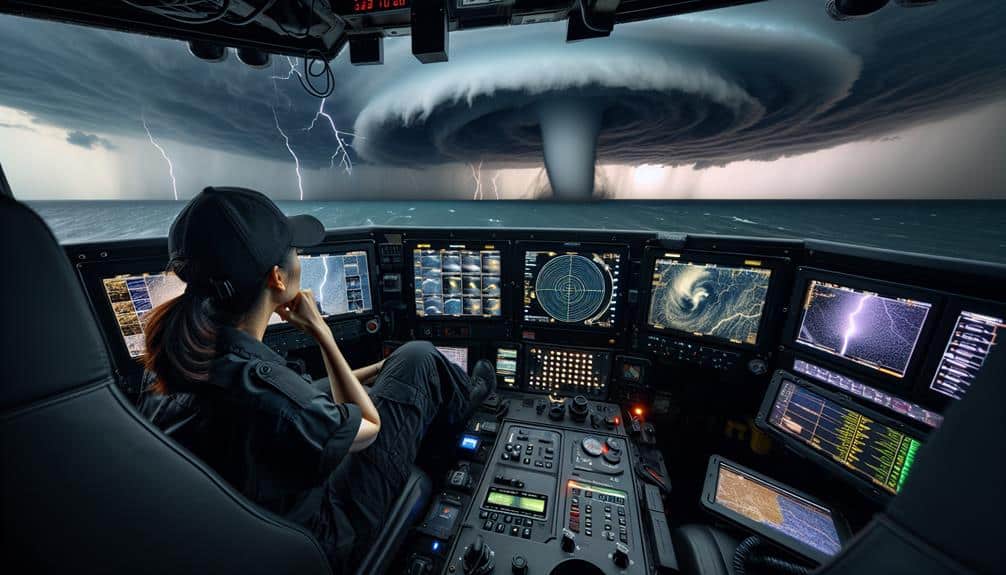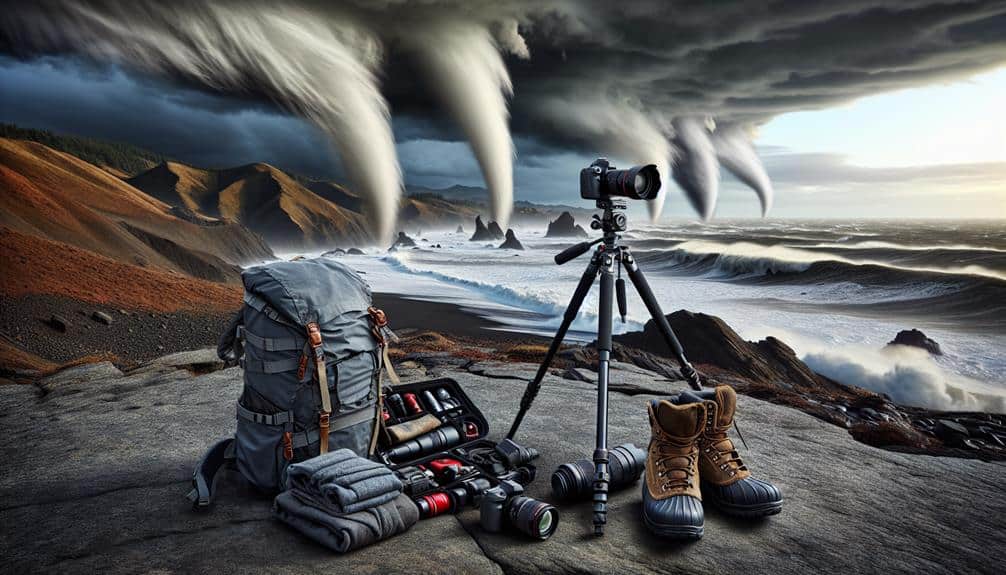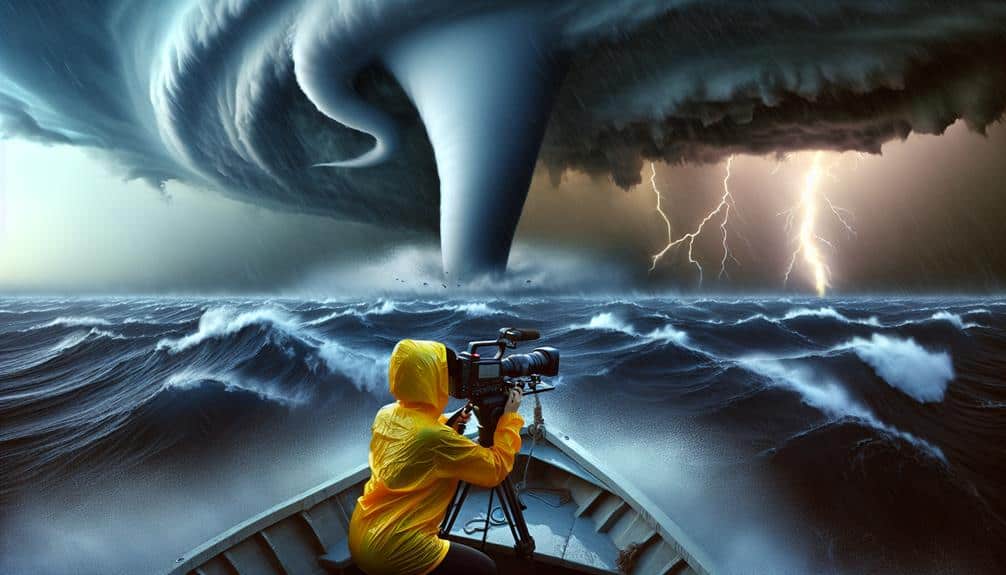Our waterspout chasing adventures are thrilling and intense. We rely on sophisticated radar, satellite imagery, and precise wind pattern analysis to pinpoint where waterspouts will form. Armed with high-resolution cameras, GPS units, and safety gear, we navigate coastal waters, always prepared for the unexpected. Each chase demands flawless strategy, real-time alerts, and a respect for nature's raw power. Capturing the perfect shot amid roaring winds and towering seas is an adrenaline rush like no other. Join us as we dive deeper into this electrifying blend of science, preparation, and sheer excitement.
Key Points
- Assess wind patterns, temperature gradients, and humidity levels to pinpoint waterspout formation hotspots.
- Equip vessels with GPS, radar, high-resolution cameras, and safety gear for effective and secure storm chasing.
- Capture stunning photographs by strategically positioning, adjusting camera settings, and using burst mode.
- Formulate escape routes, emergency plans, and maintain constant communication for safety.
Preparing for the Chase
Before we start our waterspout chasing adventure, we need to carefully gather the right gear and study the latest weather forecasts. This is where our journey truly begins.
We'll delve into storm tracking technologies, examining every atmospheric detail. Radar systems and satellite imagery become our closest allies, painting vivid pictures of potential waterspout hotspots. We analyze wind patterns, temperature gradients, and humidity levels, all of which help us anticipate the formation of these mesmerizing phenomena.
As we pore over this data, it's crucial to craft thorough emergency plans. We need to contemplate every “what if” scenario, ensuring our safety in the midst of unpredictable weather. This involves mapping out escape routes, knowing the nearest safe havens, and having a solid communication strategy. We'll set up real-time alerts, ensuring we can relay critical information swiftly.
Our preparation doesn't just stop at understanding weather patterns and safety protocols. It's also about fostering a mindset ready for the thrill and unpredictability of the chase. By equipping ourselves with knowledge and foresight, we embrace the freedom and excitement that comes with tracking nature's most elusive spectacles.
Essential Gear Checklist
Equipped with cutting-edge technology and necessary safety gear, we're ready to immerse ourselves in the exhilarating world of waterspout chasing. Our adventures demand precision, preparedness, and the right equipment to capture nature's fury while keeping ourselves safe.
Here's our essential gear checklist:
- Weather Radar and GPS Units: These are the backbone of our operations. With constant tech upgrades, our radar helps us detect waterspouts in real-time, while GPS ensures we navigate accurately, vital for both chasing and safety.
- High-Resolution Cameras and Drones: Capturing the awe-inspiring phenomena requires quality equipment. Our drones provide aerial views, offering perspectives we can't achieve from the ground.
- Safety Gear: Helmets, life vests, and first aid kits are non-negotiables. Proper gear maintenance is important; we inspect everything before each chase to make sure it's in perfect condition. It's also essential to have solid emergency procedures in place, ensuring we're ready for any unforeseen circumstances.
- Communication Devices: Reliable radios and satellite phones keep us connected, regardless of how remote our location. Clear communication can be the difference between a successful chase and a risky situation.
With our meticulously maintained gear and sharpened navigation skills, we're prepared for any challenge the sea throws our way.
As we navigate the coastal waters, we'll monitor weather patterns closely to predict the formation of waterspouts.
Let's prioritize safety with precaution measures and guarantee our equipment and gear are in top shape.
With our knowledge and preparedness, we'll face the sea's challenges head-on.
Weather Patterns Analysis
How do we decipher the intricate dance of weather patterns when sailing through the ever-changing coastal waters? It all starts with understanding the tools and techniques that lead us.
Satellite imagery and storm tracking are our eyes in the sky, revealing the hidden movements of atmospheric conditions. These high-definition images allow us to pinpoint developing systems and anticipate their paths, giving us a strategic advantage.
Wind patterns play a pivotal role, too. By analyzing them, we can predict not just where a storm might form, but also how it will behave once it does. The interplay between wind and water creates a dynamic environment that demands our full attention.
Here's our approach to navigating these waters:
- Monitor satellite imagery: Constantly check for updates to identify emerging weather systems.
- Track storms meticulously: Use advanced software to follow the trajectory and intensity of storms.
- Analyze wind patterns: Study how wind direction and speed influence storm development.
- Assess atmospheric conditions: Evaluate humidity, temperature, and pressure to gauge storm potential.
Together, these elements form a detailed picture that guides us through the thrilling yet unpredictable waterspout-chasing adventures we live for.
Let's embrace the freedom of the chase!
Safety Precaution Measures
Staying safe while traversing coastal waters demands our utmost vigilance, especially when chasing the elusive beauty of waterspouts. The adrenaline rush is undeniable, but we must always prioritize safety. Our first task is a thorough risk assessment.
Before we even set sail, we study weather forecasts and local maritime reports to identify potential hazards. Coastal waters can be unpredictable, and we must remain aware of the changing conditions around us.
Once on the water, constant communication is key. We equip ourselves with reliable marine radios to stay in touch with coastal authorities and fellow chasers. In the event of an emergency, quick and coordinated communication can be the difference between a narrow escape and disaster.
We also establish clear emergency response protocols, ensuring everyone on board knows their role during a crisis. This includes understanding how to evacuate the boat quickly, use signaling devices, and administer basic first aid. Life vests are non-negotiable – they're worn at all times, no exceptions.
Navigating the thrill of waterspout chasing requires a balance of daring and caution. By respecting the power of nature and preparing meticulously, we can embrace our freedom without compromising our safety.
Equipment and Gear Essentials
Equipping ourselves with the right gear is essential for traversing the thrilling yet treacherous coastal waters in our quest for waterspouts. Every piece of equipment we carry is meticulously chosen to guarantee our safety and enhance our storm tracking capabilities. The coastal waters are unpredictable, so we need to be prepared for anything.
First on our list is the boat. We opt for a sturdy, reliable vessel equipped with GPS and radar for real-time navigation and storm tracking. This ensures we stay on course and can quickly adjust our path if necessary.
Next, our camera setup is vital. High-resolution cameras with waterproof housings allow us to capture the raw power of waterspouts. Tripods with flexible legs are essential for steady shots on rocking boats.
Third, safety gear is non-negotiable. Life vests, first-aid kits, and emergency flares are must-haves. We never compromise on safety.
Capturing the Perfect Shot
With our cameras ready and adrenaline pumping, we position ourselves strategically to frame the waterspout against the dramatic backdrop of the stormy sky. Storm photography demands precision and a keen eye for detail. We focus on capturing not just the waterspout itself, but the powerful interplay between the swirling vortex and the turbulent clouds above. Using expert tips we've gathered over the years, we adjust our camera settings—shutter speed, aperture, and ISO—to make certain every shot is crisp and evocative.
Waterspout documentation requires specific techniques. First, we use a wide-angle lens to encapsulate the full breadth of the scene, giving a sense of scale and intensity. As the waterspout dances across the ocean, we switch to a telephoto lens for close-ups that highlight its raw power and intricate structure. Patience is key; we wait for the perfect moment when the light, angle, and movement align harmoniously.
We also employ burst mode to capture a sequence of shots, making sure we don't miss a single dramatic twist or turn. Our goal is to create a visual narrative that conveys the awe-inspiring beauty and ferocity of nature's most mesmerizing phenomena.
Safety Precautions

Our waterspout chasing adventures demand strict adherence to safety protocols to guarantee we stay out of harm's way while capturing nature's fury. We can't afford to be reckless, so we meticulously plan our chases with a sharp focus on safety.
Here's how we make sure our epic journeys are as safe as they're thrilling:
- Risk Assessment: Before heading out, we analyze weather data and identify potential dangers. Understanding the storm's trajectory helps us avoid the most dangerous areas.
- Communication Strategies: We maintain constant contact using radios and GPS tracking. This secures we can coordinate our movements and respond quickly to any changes in the storm's behavior.
- Storm Shelters and Emergency Plans: Knowing the locations of nearby storm shelters is essential. We've mapped out emergency plans that include safe spots and the quickest escape routes should the waterspout become too menacing.
- Equipment Checks: Regular inspections of our vehicles, cameras, and safety gear are non-negotiable. Reliable equipment is vital for both documenting the storm and ensuring our personal safety.
Memorable Encounters
We've had some heart-pounding moments, like when we found ourselves closer to a tornado than planned. The sudden roar of the wind and the sight of twisting columns of water left us in awe.
Those unforgettable formations, spiraling gracefully yet menacingly, are seared into our memories.
Unexpected Tornado Proximity
During one of our most thrilling chases, a waterspout unexpectedly morphed into a tornado, hurtling towards us with a ferocity that left us both awestruck and scrambling for safety. The stormy surprises we encountered that day gave us an adrenaline rush like no other.
We were initially mesmerized by the waterspout's graceful dance on the ocean, but that quickly turned into a series of close calls and thrilling experiences as it transformed and began its terrestrial rampage.
We had to act fast. Here's how we handled the situation:
- Assess the Tornado's Path: Using our radar and visual cues, we quickly determined the tornado's trajectory.
- Find Shelter: We sought immediate refuge in a nearby sturdy structure, minimizing our exposure to flying debris.
- Document the Experience: Even in the chaos, we managed to capture footage and data, contributing valuable information to the storm-chasing community.
- Evacuation Plan: We'd a pre-determined route to get out of the danger zone swiftly, ensuring our safety and enabling us to continue chasing another day.
This unforgettable encounter solidified our respect for nature's raw power and our commitment to chasing storms with both caution and enthusiasm.
Unforgettable Waterspout Formations
Amidst the excitement of our storm-chasing adventures, certain waterspout formations stand out, etching unforgettable images into our memories with their mesmerizing yet formidable displays. We've witnessed the breathtaking beauty of these natural wonders from an aerial perspective, a vantage point that grants us a grand view of their raw power and elegance. The swirling columns of water and mist, spiraling upwards against the backdrop of a stormy sky, create scenes that are both enchanting and humbling.
One memorable encounter took place off the coast of Key West, where we tracked a massive waterspout that danced across the ocean's surface. The extreme weather conditions were both exhilarating and intense, as we navigated through powerful gusts of wind and torrential rain. The waterspout's sheer size and the speed at which it rotated were a tribute to nature's unrestrained force.
Another unforgettable formation occurred near the Great Lakes, where multiple waterspouts appeared simultaneously, creating a surreal and almost otherworldly panorama.
These moments remind us why we chase storms: to witness the untamed artistry of nature, to feel the pulse of the Earth's most dramatic displays, and to embrace the freedom that comes with exploring the unknown.
Frequently Asked Questions
How Do Waterspouts Form Compared to Tornadoes?
Weather patterns dance like wild spirits; waterspouts form over water with warm, moist air, while tornadoes form over land. Both impact the landscape fiercely, but their formation processes differ greatly when we compare their origins.
What Is the Best Time of Year for Waterspout Chasing?
We find the best time for chasing waterspouts in late summer and early fall, particularly in ideal locations like the Florida Keys. While storm chasing, we always follow safety precautions to guarantee our thrilling adventures remain secure.
Can Waterspouts Cause as Much Damage as Tornadoes?
Did you know waterspout strength can rival weak tornadoes? While waterspout damage tends to be less severe, tornado vs. waterspout damage comparisons reveal waterspouts can still cause significant destruction, especially to coastal areas. Let's explore!
How Do You Identify the Different Types of Waterspouts?
We identify different types of waterspouts using spotting techniques, weather patterns, and our trusty equipment. We always prioritize safety precautions. Adventurously, we scan the horizon, analyze storm formations, and rely on radar to track these mesmerizing phenomena.
What Are the Legal Restrictions for Storm Chasers on Open Waters?
Did you know that 70% of storm chasers face legal restrictions on open waters? We must follow safety protocols, including avoiding restricted zones and adhering to maritime laws, ensuring both our safety and the freedom to chase storms.


